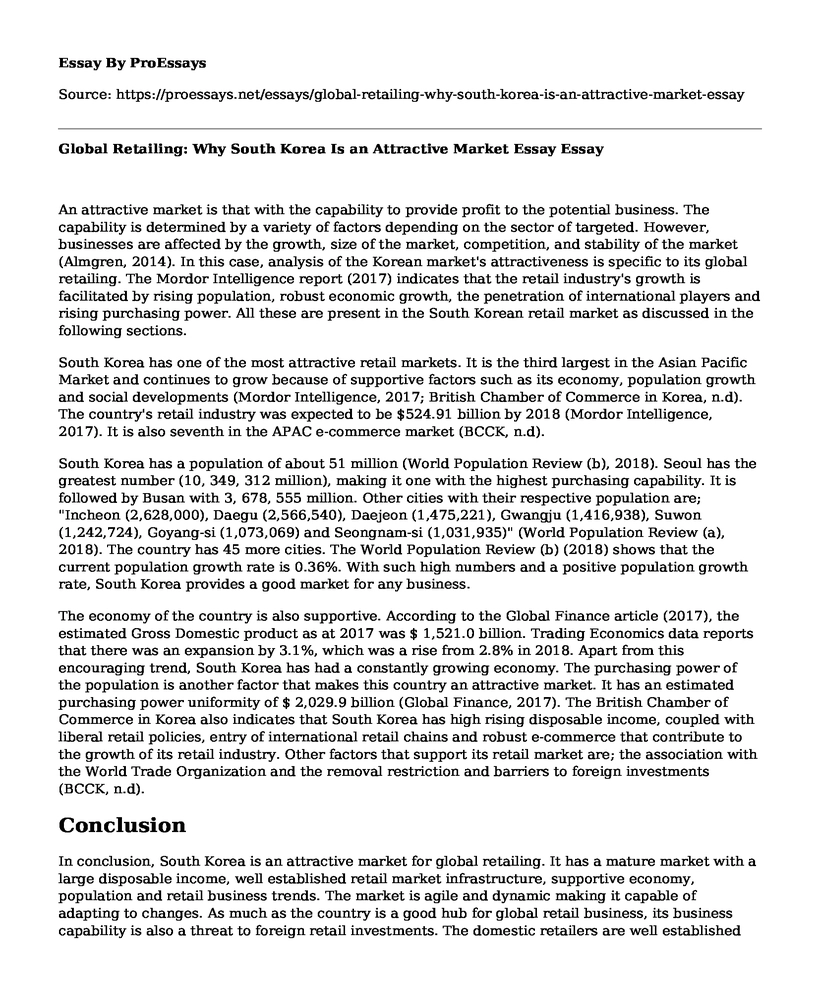An attractive market is that with the capability to provide profit to the potential business. The capability is determined by a variety of factors depending on the sector of targeted. However, businesses are affected by the growth, size of the market, competition, and stability of the market (Almgren, 2014). In this case, analysis of the Korean market's attractiveness is specific to its global retailing. The Mordor Intelligence report (2017) indicates that the retail industry's growth is facilitated by rising population, robust economic growth, the penetration of international players and rising purchasing power. All these are present in the South Korean retail market as discussed in the following sections.
South Korea has one of the most attractive retail markets. It is the third largest in the Asian Pacific Market and continues to grow because of supportive factors such as its economy, population growth and social developments (Mordor Intelligence, 2017; British Chamber of Commerce in Korea, n.d). The country's retail industry was expected to be $524.91 billion by 2018 (Mordor Intelligence, 2017). It is also seventh in the APAC e-commerce market (BCCK, n.d).
South Korea has a population of about 51 million (World Population Review (b), 2018). Seoul has the greatest number (10, 349, 312 million), making it one with the highest purchasing capability. It is followed by Busan with 3, 678, 555 million. Other cities with their respective population are; "Incheon (2,628,000), Daegu (2,566,540), Daejeon (1,475,221), Gwangju (1,416,938), Suwon (1,242,724), Goyang-si (1,073,069) and Seongnam-si (1,031,935)" (World Population Review (a), 2018). The country has 45 more cities. The World Population Review (b) (2018) shows that the current population growth rate is 0.36%. With such high numbers and a positive population growth rate, South Korea provides a good market for any business.
The economy of the country is also supportive. According to the Global Finance article (2017), the estimated Gross Domestic product as at 2017 was $ 1,521.0 billion. Trading Economics data reports that there was an expansion by 3.1%, which was a rise from 2.8% in 2018. Apart from this encouraging trend, South Korea has had a constantly growing economy. The purchasing power of the population is another factor that makes this country an attractive market. It has an estimated purchasing power uniformity of $ 2,029.9 billion (Global Finance, 2017). The British Chamber of Commerce in Korea also indicates that South Korea has high rising disposable income, coupled with liberal retail policies, entry of international retail chains and robust e-commerce that contribute to the growth of its retail industry. Other factors that support its retail market are; the association with the World Trade Organization and the removal restriction and barriers to foreign investments (BCCK, n.d).
Conclusion
In conclusion, South Korea is an attractive market for global retailing. It has a mature market with a large disposable income, well established retail market infrastructure, supportive economy, population and retail business trends. The market is agile and dynamic making it capable of adapting to changes. As much as the country is a good hub for global retail business, its business capability is also a threat to foreign retail investments. The domestic retailers are well established with vast knowledge of the local market, and as indicated earlier, one of the factors to consider when analyzing a market is competition. With these establishments, any business organization intending to do retail business must analyze the market further for profitability capability. The global trend of business is however supportive of global retail businesses in various countries.
References
Almgren, K. (2014). The four factors for targeting an attractive market. International Journal of Humanities and Social Science, 4 (1): 71-76.
British Chamber of Commerce in Korea (BCCK). (n.d). Retail. Retrieved on 18th April 2018 from: http://bcck.or.kr/sectors/retail/
Global Finance. (2017). South Korea GDP and Economic Data. Retrieved on 18th April 2018 from: https://www.gfmag.com/global-data/country-data/south-korea-gdp-country-report---R4
Mordor Intelligence. (2017). South Korea retail industry - Major trends, growth and opportunities (2016 - 2021). Business Report. Retrieved on 18th April 2018 from: https://www.mordorintelligence.com/industry-reports/south-korea-retail-industry
Samil, H. A. (2016). Samil PwC's 2016 foreign business executive survey: Korea remains an attractive destination for foreign direct investment, but there are areas for improvement. PwC. Retrieved on 18th April 2018 from: https://www.pwc.com/kr/ko/Tax/samilpwc_amcham_journal.pdf
Trading Economics. (2018). South Korea Retail Sales YoY 1996-2018. Retrieved on 18th April 2018 from: https://tradingeconomics.com/south-korea/retail-sales-annual
World Population Review (a). (2018). Population of Cities in South Korea (2018). Retrieved on 18th April 2018 from: http://worldpopulationreview.com/countries/south-korea-population/cities/
World Population Review (b). (2018). South Korea population 2018. Retrieved on 18th April 2018 from: http://worldpopulationreview.com/countries/south-korea-population/
Cite this page
Global Retailing: Why South Korea Is an Attractive Market Essay. (2022, May 09). Retrieved from https://proessays.net/essays/global-retailing-why-south-korea-is-an-attractive-market-essay
If you are the original author of this essay and no longer wish to have it published on the ProEssays website, please click below to request its removal:
- Indeed.com Job Announcement Requirements Paper Example
- Social and Demographic Trends in Workstations Paper Example
- Teachers Pay Essay Example
- Economics of a Monopoly Research Paper
- Ability Matters' Supply Chain Challenges & Opportunities - Essay Sample
- Organizational Culture: Maslow's Hierarchy of Needs for Employee Motivation - Essay Sample
- Essay on Operations Management: Resource Management to Deliver Goods & Services







